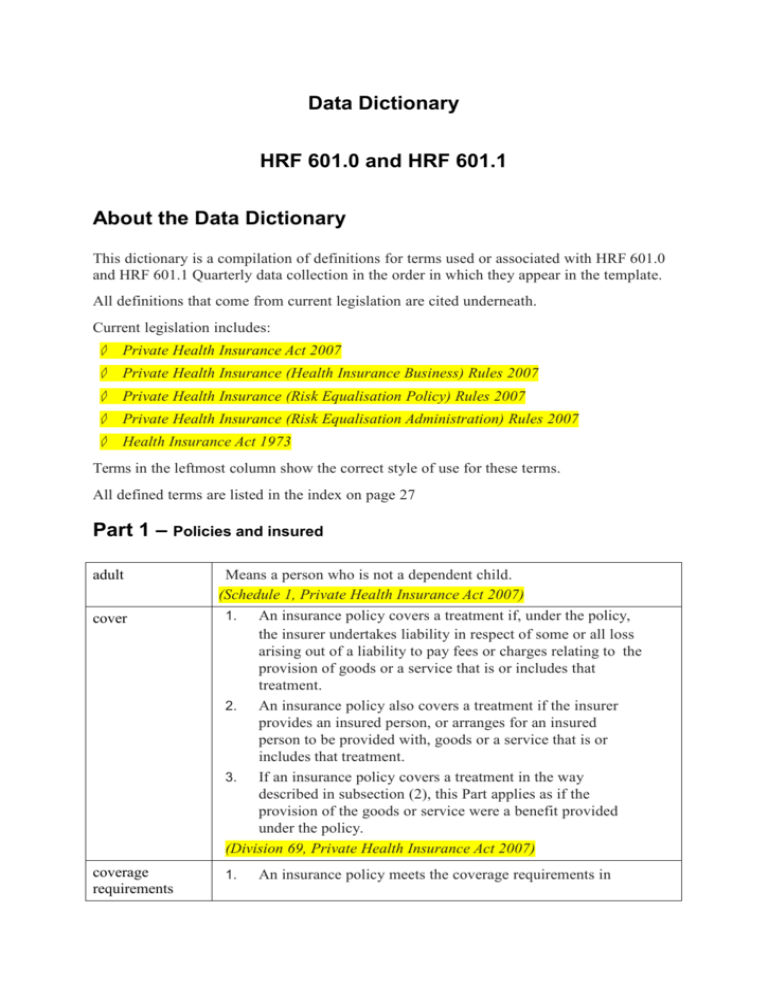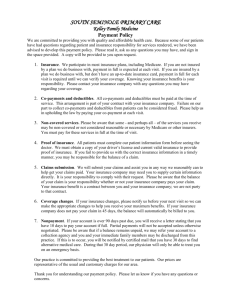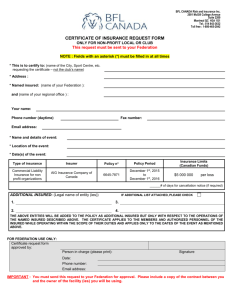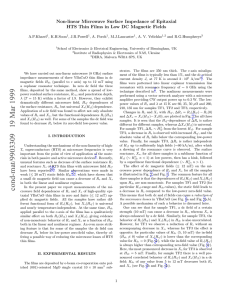Data Dictionary HRF 601.0 and HRF 601.1
advertisement

Data Dictionary HRF 601.0 and HRF 601.1 About the Data Dictionary This dictionary is a compilation of definitions for terms used or associated with HRF 601.0 and HRF 601.1 Quarterly data collection in the order in which they appear in the template. All definitions that come from current legislation are cited underneath. Current legislation includes: ◇ Private Health Insurance Act 2007 ◇ Private Health Insurance (Health Insurance Business) Rules 2007 ◇ Private Health Insurance (Risk Equalisation Policy) Rules 2007 ◇ Private Health Insurance (Risk Equalisation Administration) Rules 2007 ◇ Health Insurance Act 1973 Terms in the leftmost column show the correct style of use for these terms. All defined terms are listed in the index on page 27 Part 1 – Policies and insured adult cover coverage requirements Means a person who is not a dependent child. (Schedule 1, Private Health Insurance Act 2007) 1. An insurance policy covers a treatment if, under the policy, the insurer undertakes liability in respect of some or all loss arising out of a liability to pay fees or charges relating to the provision of goods or a service that is or includes that treatment. 2. An insurance policy also covers a treatment if the insurer provides an insured person, or arranges for an insured person to be provided with, goods or a service that is or includes that treatment. 3. If an insurance policy covers a treatment in the way described in subsection (2), this Part applies as if the provision of the goods or service were a benefit provided under the policy. (Division 69, Private Health Insurance Act 2007) 1. An insurance policy meets the coverage requirements in Division 69 if: a. the only treatments the policy covers are: specified treatments that are hospital treatment; or (i) (ii) specified treatments that are hospital treatment and specified treatments that are general treatment; or (iii) specified treatments that are general treatment but none that are hospital-substitute treatment; and b. if the policy provides a benefit for anything else—the provision of the benefit is authorised by the Private Health Insurance (Complying Product) Rules. 3. Despite paragraph (1)(a), the policy must also cover any treatment that a policy of its kind is required by the Private Health Insurance (Complying Product) Rules to cover. 4. Despite paragraph (1)(a), the policy must not cover any treatment that a policy of its kind is not allowed under the Private Health Insurance (Complying Product) Rules to cover. (Division 69, Private Health Insurance Act 2007) dependent child Means a person a. who is: (i) aged under 18: or (ii) a dependent child under the rules of the insurer that insures the person; and b. who is not aged 25 or over; and c. who does not have a partner. (Schedule 1, Private Health Insurance Act 2007) holder (of an insurance policy) Means a person who is insured under the policy and who is not a dependent child. (Schedule 1, Private Health Insurance Act 2007) insured persons All persons covered by health insurance policies. private health insurance policy Means an insurance policy that covers hospital treatment or general treatment or both (whether or not it also covers any other treatment or provides a benefit for anything else). (Schedule 1, Private Health Insurance Act 2007) Single equivalent unit/s (SEU/s) Single equivalent units (SEUs) are used as a standard measure of the different categories of policies. The Single equivalent units for each category of policy are: (a) Single―1 (b) Couple―2 (c) 2+ persons no adults―1 (d) Single parent―1 (e) Family―2 (f) 3+ adults―2 (the Preliminary section, Private Health Insurance (Risk Equalisation Administration) Rules 2007) SEUs are calculated as ([Single] + [2+ Persons no adults] + [Single parent]) + 2 x ([Couple] + [Family] + [3+ Adults]) Type of cover All definitions are taken from the Preliminary section, Private Health Insurance (Risk Equalisation Policy) Rules 2007 2 + persons, no adults A policy under which 2 or more people are insured, none of whom is an adult. 3 + adults A policy under which 3 or more people are insured, at least 3 of whom are adults. couple A policy under which 2 adults are insured (and no-one else). family A policy under which 3 or more people are insured, only 2 of whom are adults. single A policy under which only one person is insured. single parent A policy under which 2 or more people are insured, only one of whom is an adult. Type of policies Excess & Copayments Means an amount of money a policy holder agrees to pay before private health insurance benefits are payable. A copayment could apply every time a person insured under the policy goes to hospital in a year, or an excess may be capped at a total amount for the year. The terms “Excess” and “Co-payments” are sometimes referred to as “Frontend Deductibles” and are similar in meaning. For taxation purposes those taxpayers who would be subject to the Medicare Levy Surcharge are exempted if they have a hospital treatment policy with an excess no greater than $400 for a policy covering a single person or an excess no greater than $1,000 for a policy covering more than one person. Excess & Co-payments Policies- includes all policy holders who contribute to hospital treatment policies under which an agreed, excess, amount is paid by the policy holder for hospital treatment and/or general treatment services, reducing the benefit otherwise payable in exchange for lower premium costs. Note: these can be combined with exclusionary policies. Excess (also referred to as front-end deductible) An excess is an amount of money a policy holder agrees to pay for a hospital stay before health fund benefits are payable. For example, if a policy has an excess of $200, the insured person will be required to pay the first $200 of the hospital costs if they go to hospital as a private patient. An excess could apply every time the insured person goes to hospital in a year, or it may be capped at a total amount that will be paid in each year. co-payment With a co-payment, a policy holder agrees to pay an agreed amount each time a service is provided. For example, a policy may have a copayment clause that requires payment for the first $50 for each day’s hospital accommodation. If the policy has such a copayment and they were in hospital for 5 days, they would have to pay $250 ($50 x 5).The total amount of co-payment that can be paid in a year is often limited to a set maximum amount. Exclusionary Policies Means where the private health insurance policy features an exclusion for a particular condition and there is no coverage at all for medical treatment as a private patient in a public or private hospital or any other setting for that condition. Exclusionary tables exclude payment of benefits for a particular condition in all settings. (This does not refer to the case where the policy only covers the medical services to a limited extent, only in certain settings or only after a certain time.) No Excess & No Co- payment Means all policies other than Excess & Co-payments Policies. The sum of Excess & Co-payments and No Excess & No Co-payments policies will reflect the total hospital treatment policies. NonExclusionary Policies Means the policy does not have any exclusions (see Exclusionary Policies) The sum of exclusionary and non-exclusionary policies will reflect the total hospital treatment policies. NB: Where a product only relates to select hospitals but covers all treatment in those hospitals the policies should be included in the nonexclusionary category. Errors to avoid: The majority of errors that come to PHIAC’s attention for exclusionary policy holders are where treatment is excluded in some, but not all, settings where the product can be utilised but the policy holders are counted as exclusionary. For example, if treatment is excluded in a private hospital but not excluded in a public hospital the member with that product should not be counted as an exclusionary policy holder. The HRF 601.0 series includes Form HRF 601.0 Statistical Data – Cover Page (HRF 601.0) and Form HRF 601.1 Statistical Data - by State (HRF 601.1) that collect statistical data on a State or Territory basis. The HRF 601.0 series must be completed for each health benefits fund of the private health insurer. Disclaimer In the case of any contradiction between these reporting instructions and the relevant legislation, the legislation should be deemed to be the correct interpretation. Definitions Definitions for terms used in these reporting instructions can be found in the Attachment to these reporting instructions. ‘The Act’ refers the Private Health Insurance (Prudential Supervision) Act 2015.







